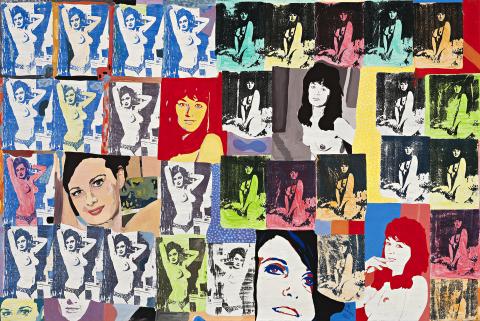UNTITLED, 1971
RICHARD LARTER
enamel on composition board
122.5 x 183.5 cm
signed and dated lower right: R. / LARTER. / 1971.
Watters Gallery, Sydney
The Collection of Colin and Elizabeth Laverty, Sydney, acquired from the above in August 1991
The following excerpt is quoted from Tunnicliffe, W., 'The Easel Did Not Go Pop: It Went Bang!’, Pop To Popism, Art Gallery of New South Wales, Sydney, 2014, p. 140
- From the mid 1950s Larter was drawn to contemporary urban life in the streets, cafes, pubs and strip clubs of London. He cites Kitchen Sink School artist John Bratby as an influence, and particularly his technique of painting multiple viewpoints in one painting.1 Larter saw the seminal This is tomorrow exhibition at Whitechapel Art Gallery in 1956, and admired the work of David Hockney and RB Kitaj in particular at the Young contemporaries exhibitions in London. The collage aesthetic on display in This is tomorrow and in the accompanying catalogue, and Eduardo Paolozzi’s earlier collages made from glossy American magazines, which began to be displayed from the mid 1950s, were a precedent for Larter’s own extensively practiced collaging.2 Larter’s liberated attitude towards sexual expression had full reign from the early 60s, and freed from the formal limitations of his idiosyncratic application of paint through syringes when they became hard to get after 1965, Larter developed a more overtly pop, flat, frontal style in which clamorous multiple painted images are connected through areas of abstract patterning.
1. Hart, D., Richard Larter, National Gallery of Australia, Canberra, 2008, p. 37
2. Larter may have attended Eduardo Paolizzi’s lecture at the Institute of Contemporary Arts in 1954, in which he projected through an epidiascope collages made from cut-outs of American mass-market magazines (see Hart, D.,2008, p. 25), but is more likely to have seen Paolizzi’s collages when exhibited in 1954.
